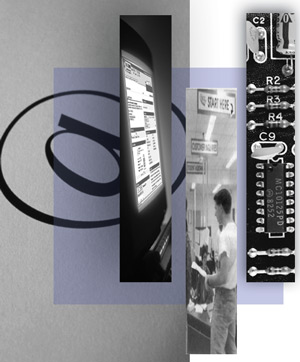| |
A Busy Decade for the Computing Help Desk
By Jeff van de Pol
In the Beginning was the CAPIn 1992, a major campus reorganization grouped several technology-related units together under the newly formed Department of Information Technology (IT) banner. With all of these units now “under one roof,” the idea was developed to create a central place on campus where faculty, staff and students could get answers for all of their computing and technology questions. From these discussions was born the Information Technology Campus Access Point (also called IT-CAP, or “the CAP”).
The Big Move, and a Name ChangeCoinciding with this staffing revamp, IT-CAP changed locations, moving out of Surge II in Summer 1994. The walk-in help desk services were relocated to the first floor of Shields library (in room 182, where they are still located today), and the phone-in services and offices, after a brief stay on the fifth floor of the Chemistry Annex, moved to Academic Surge. “The move to Shields Library provided IT-CAP with a more centralized location that offered higher traffic and visibility,” says Patrette, “and allowed us to provide a more effective and efficient level of service.” Reflecting these changes, the IT-CAP name was changed shortly thereafter to “Information Express” and later shortened to IT Express. The Internet Explosion and the Rise of EmailNo sooner had IT Express moved into its new location, there occurred perhaps the most significant computing and technology change in recent history—the explosion of the Internet. With the release of the first graphical browsers, Mosaic and Netscape 1.0, and other freely available computer applications, students, staff and faculty quickly grew eager to check out the “new” inventions, the World Wide Web and electronic mail. As demand grew, IT Express quickly felt the crunch. Tim Leamy, a previous IT Express student employee who now works as Computer Lab Manager, explains: “Back then, modem speeds were so slow that downloading applications like browsers wasn’t feasible—it would literally take days to download.” The result: everybody who needed a browser or email application went to IT Express to get it. “At the time, a client could bring in a blank floppy disk, which would be exchanged with a floppy that contained the applications they needed,” says Leamy. Still, the process took a lot of time, and Leng Siakkhasone, a programmer with IT Express who also started working with the unit as a student employee, remembers consistently long lines. “It seemed like there was always a line, and I spent most of my first year with IT Express copying applications onto disks over and over and over….”shares Siakkhasone. “It was almost impossible to keep up with demand.” Bovine Online To The RescueTo better handle the enormous demand, the decision was made to create an Internet software package specifically designed for the UC Davis community, which could be produced in large quantities and made available at other locations on campus. In 1996, Bovine Online 1.0 was released. Packaged in an easily customizable small binder, Bovine Online 1.0 was sold at the UC Davis Bookstore and included a series of floppy disks with Internet software, and campus computing account and modem connection information. The creation of Bovine Online proved to be doubly helpful, as the campus was able to obtain what it needed to access the Internet and email without standing in long lines, and IT Express could focus its resources and quickly assist clients who had specific computing problems. The Internet Software Toolkit (now at version 7.0 and available on CD) has won several national awards over the years and has become a ubiquitous part of the campus computing landscape. Times, and Clients, Have ChangedIn the years since the Internet explosion, even as technology has grown ever more advanced and powerful, so too has the computing knowledge and expertise of the campus community. “Ten years ago, relatively few people owned computers, and the majority of the questions we answered were either from Computer Science majors, or people who had never touched a computer before,” shares Patrette. “Today, people are much more comfortable with computers, and recognize the important role they play in our lives.” Some things do remain the same. “Unfortunately, problems with computer hardware and software still arise,” says Patrette. However, regardless of what the next ten years will bring, “we will still be here to answer your questions and provide the best technical support possible.” |


